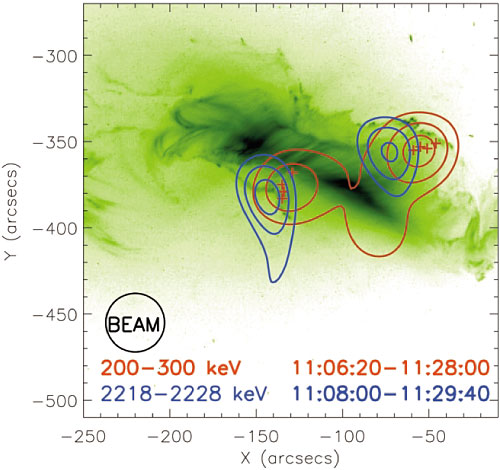The sun in the MeV domain
The Sun is an efficient particle accelerator during flares. Energetic electrons (of energies >20 keV to 100 MeV) produce a strong X-ray/gamma-ray continuum via bremsstrahlung radiation in the solar atmosphere. Energetic ions (a few MeV/nucleon to GeV/nucleon) produce a complete spectrum of gamma-ray lines through nuclear interactions with the solar atmosphere (prompt deexcitation lines from e.g. 12C* at 4.44 MeV and 16O* at 6.2 MeV but also a neutron capture line at 2.2 MeV from n + H → D + 2.2 MeV photons) and also for the most energetic ions gamma-ray emission (in the 100 MeV range) from pion-decay radiation. The most recent observations of solar flares at high energies have been performed with the solar dedicated mission RHESSI. A few solar flares have also been observed by INTEGRAL/SPI (through the anticoincidence shield and by the shield itself). Solar observations are also obtained with FERMI. There are still a limited number of flares with well-observed gamma-ray line spectra (~30), and a limited number of events observed at 100 MeV (~20). There are still many unresolved questions on, e.g., the link between electron and ion acceleration in flares, or the angular distributions of accelerated electrons and ions, which all need observations with a higher line sensitivity, a good spectral resolution and potentially polarization measurements (in the continuum above a few hundred keV).
After a solar flare, the Sun is predicted to produce gamma-ray emission through radioactive decay (e.g. lines at 847 and 1434 keV from the decay of 56Co and 52Mn, respectively). The detection of these lines would provide additional information on energy spectra and composition of flare-accelerated particles, as well as on mixing processes in the solar atmosphere. These lines have been searched for with RHESSI, after large flares, but with no success.
Required instrument performances:
An energy resolution of 1% to 2% at ~5 MeV is required to measure the gamma-ray profiles of the C and O lines
After a solar flare, the Sun is predicted to produce gamma-ray emission through radioactive decay (e.g. lines at 847 and 1434 keV from the decay of 56Co and 52Mn, respectively). The detection of these lines would provide additional information on energy spectra and composition of flare-accelerated particles, as well as on mixing processes in the solar atmosphere. These lines have been searched for with RHESSI, after large flares, but with no success.
 Gamma-ray emission observed with RHESSI (red and blue contours) overlaid on the negative of a TRACE 195 Å image dominated by the emission of Fe XII. The contours (at 50%, 70%, and 90% of the peak value) show – in red – the electron bremsstrahlung in the range 200 – 300 keV and – in blue – the deuterium recombination line at 2.223 MeV. The centroid positions of the bremsstrahlung emission at different times are indicated by plus signs. Credit: Hurford et al. 2006, ApJ 644, L93 |
Required instrument performances:
An energy resolution of 1% to 2% at ~5 MeV is required to measure the gamma-ray profiles of the C and O lines
| Performance parameter | Goal value | Remarks and notes |
|
Field-of-view (FWHM, deg) |
Can be potentially pointed to the Sun? | |
|
Angular resolution (FWHM, deg) |
Arc min ? | |
|
Spectral resolution (ΔE/E @ Energy) |
1% to 2% at ~ 5 MeV | |
|
Line sensitivity (@ Energy) (cm-2 s-1, 3σ, 1 Ms) |
~ 10-6 @ 1 MeV | To detect delayed gamma-ray lines in the aftermath of large flares |
|
Continuum sensitivity (in which energy band?) (cm-2 s-1 keV-1, ΔE=E, 3σ, 1 Ms) |
|
|
| Timing performances |
< 1 ms |
|
|
Polarimetric capability (Minimum Polarization Fraction for a Crab source in 1 Ms) |
|
Interesting in the continuum above 100 keV (not too many observations) |
| Real-time data? |
 AstroMeV
AstroMeV